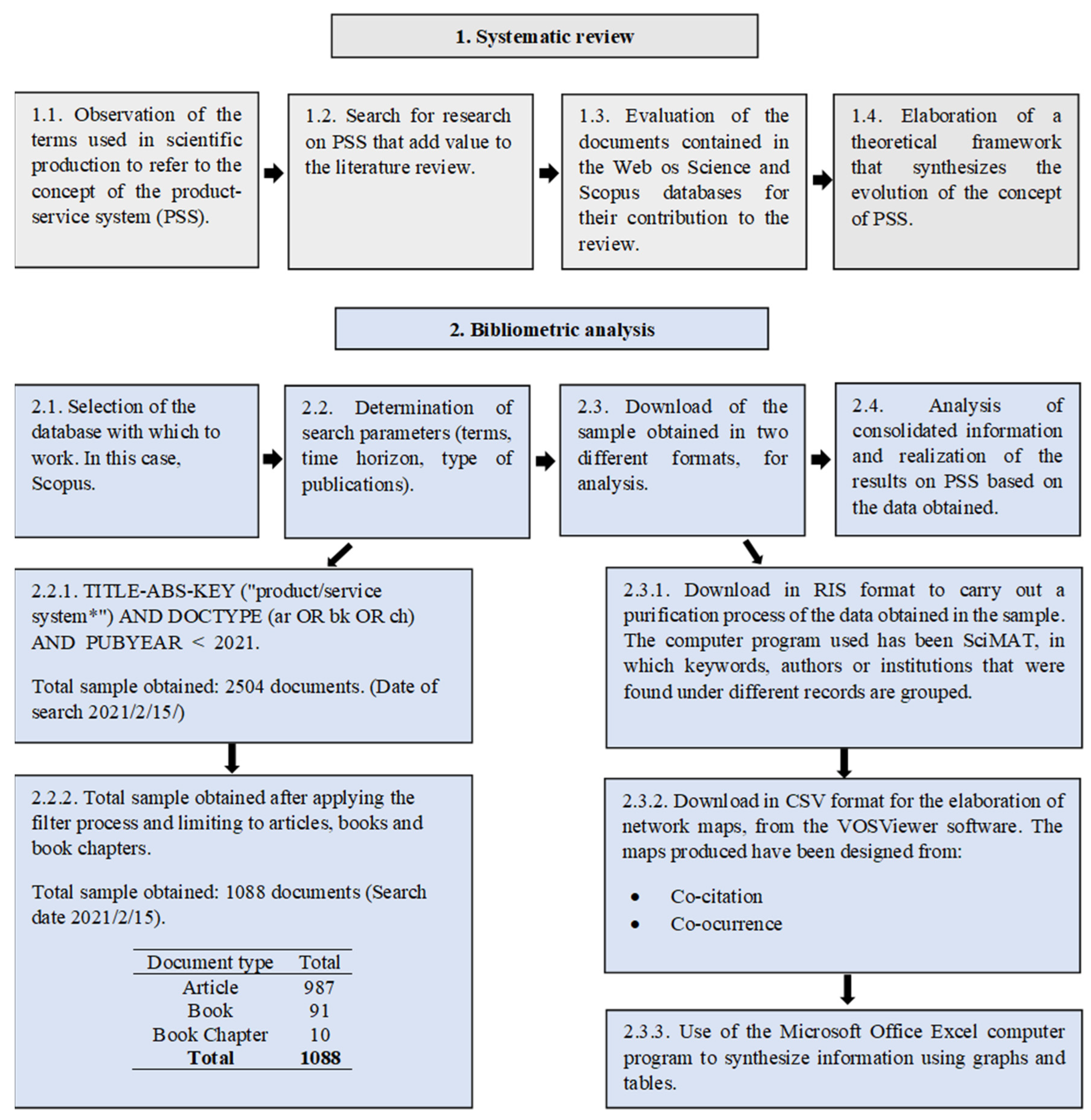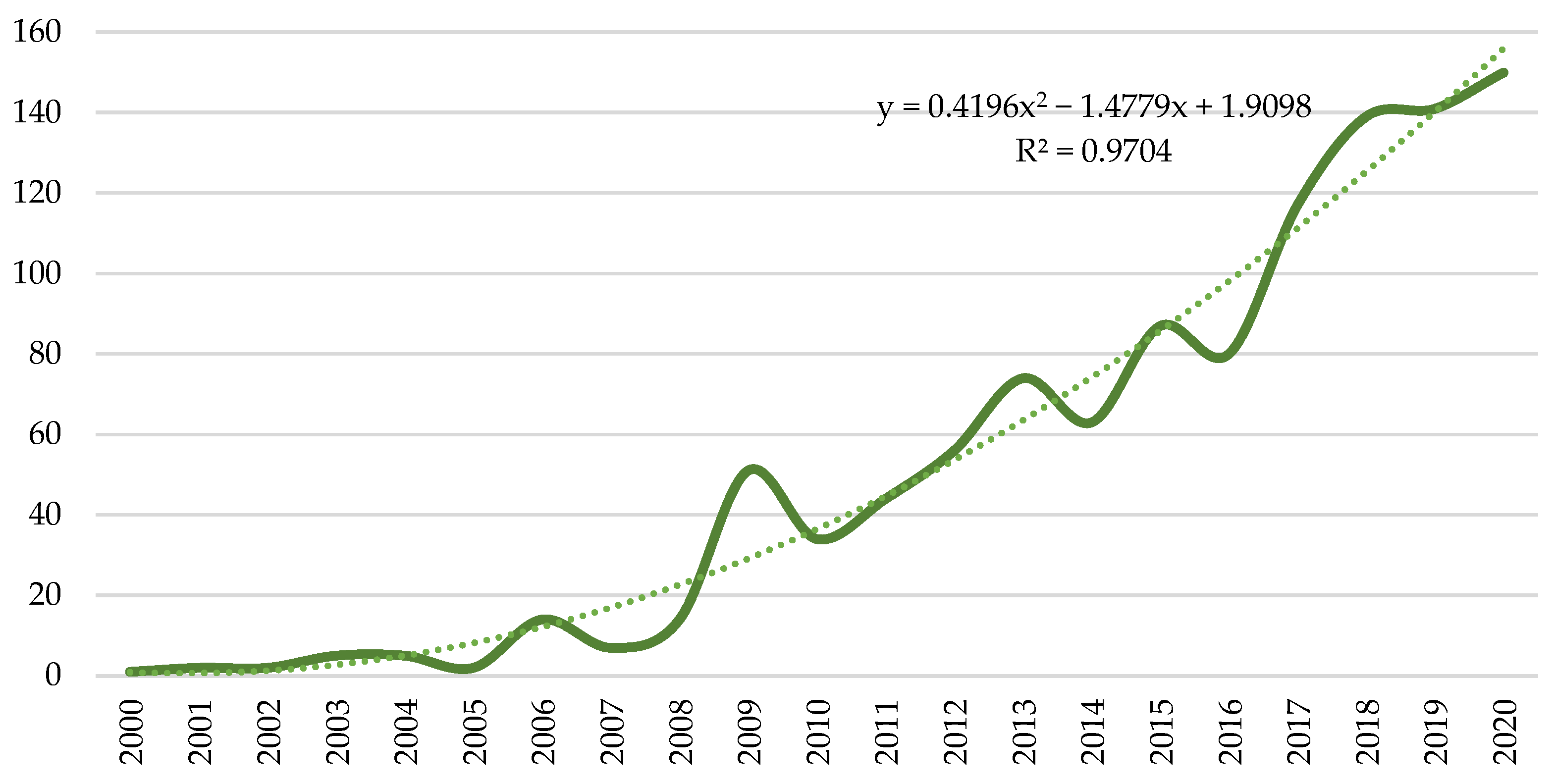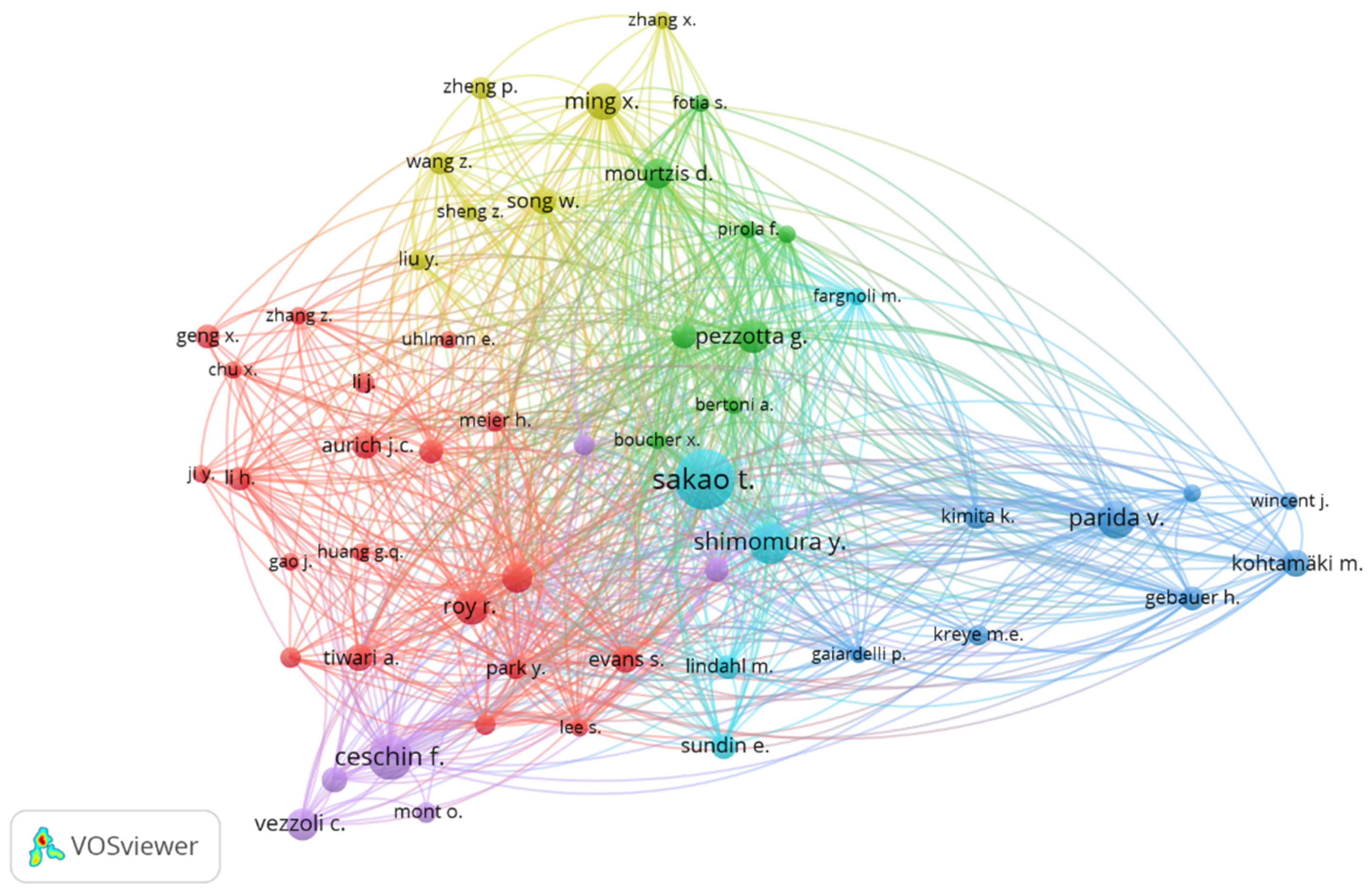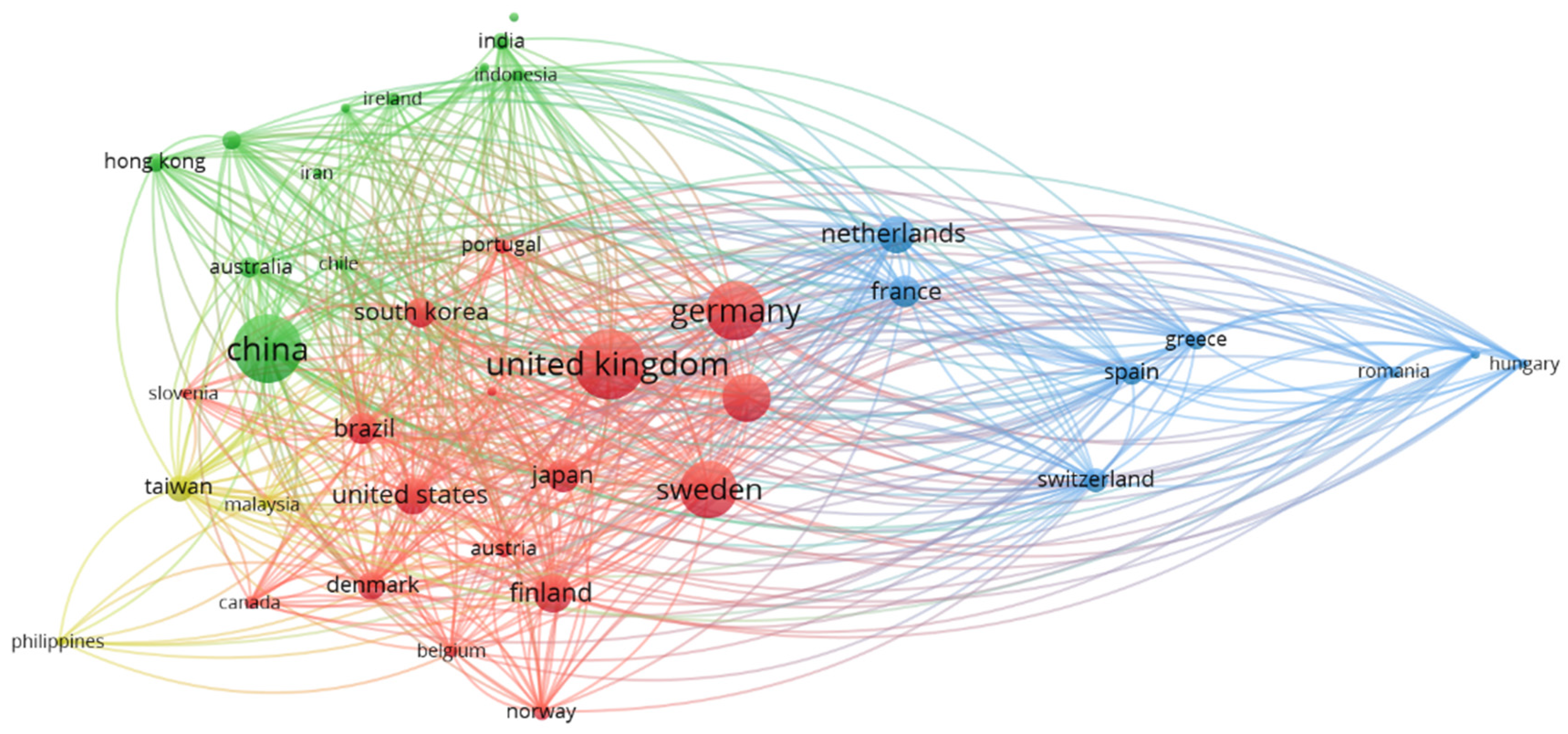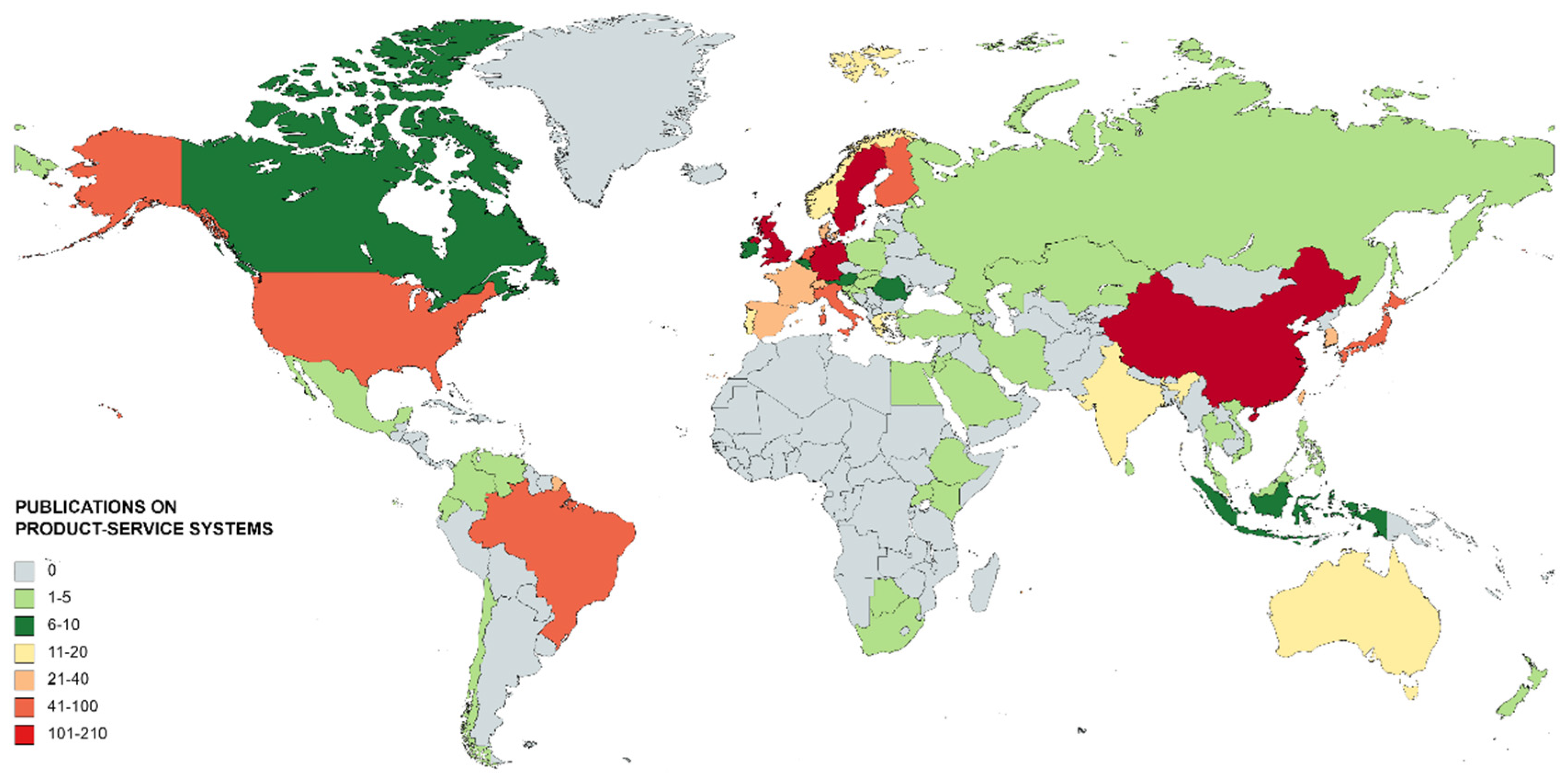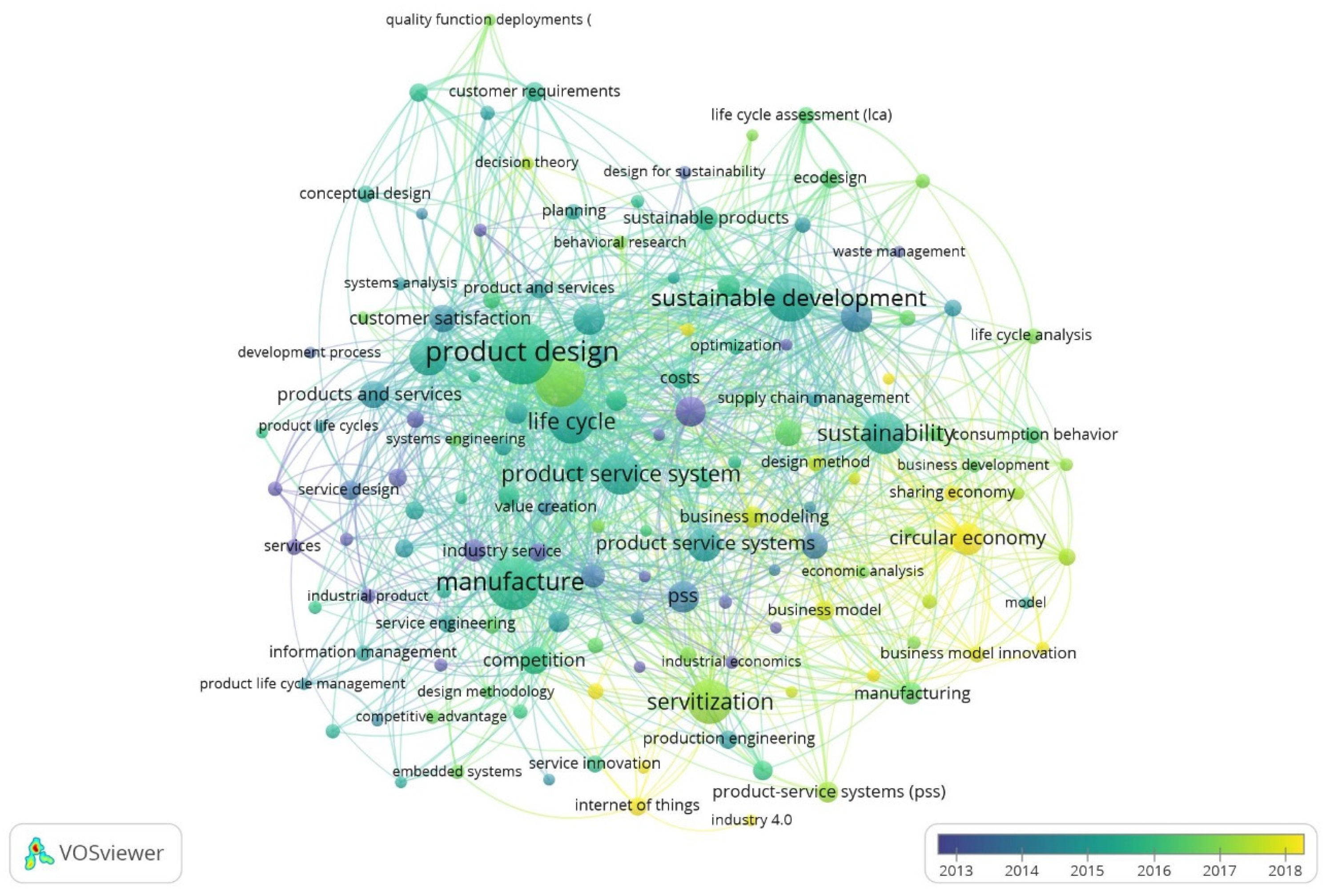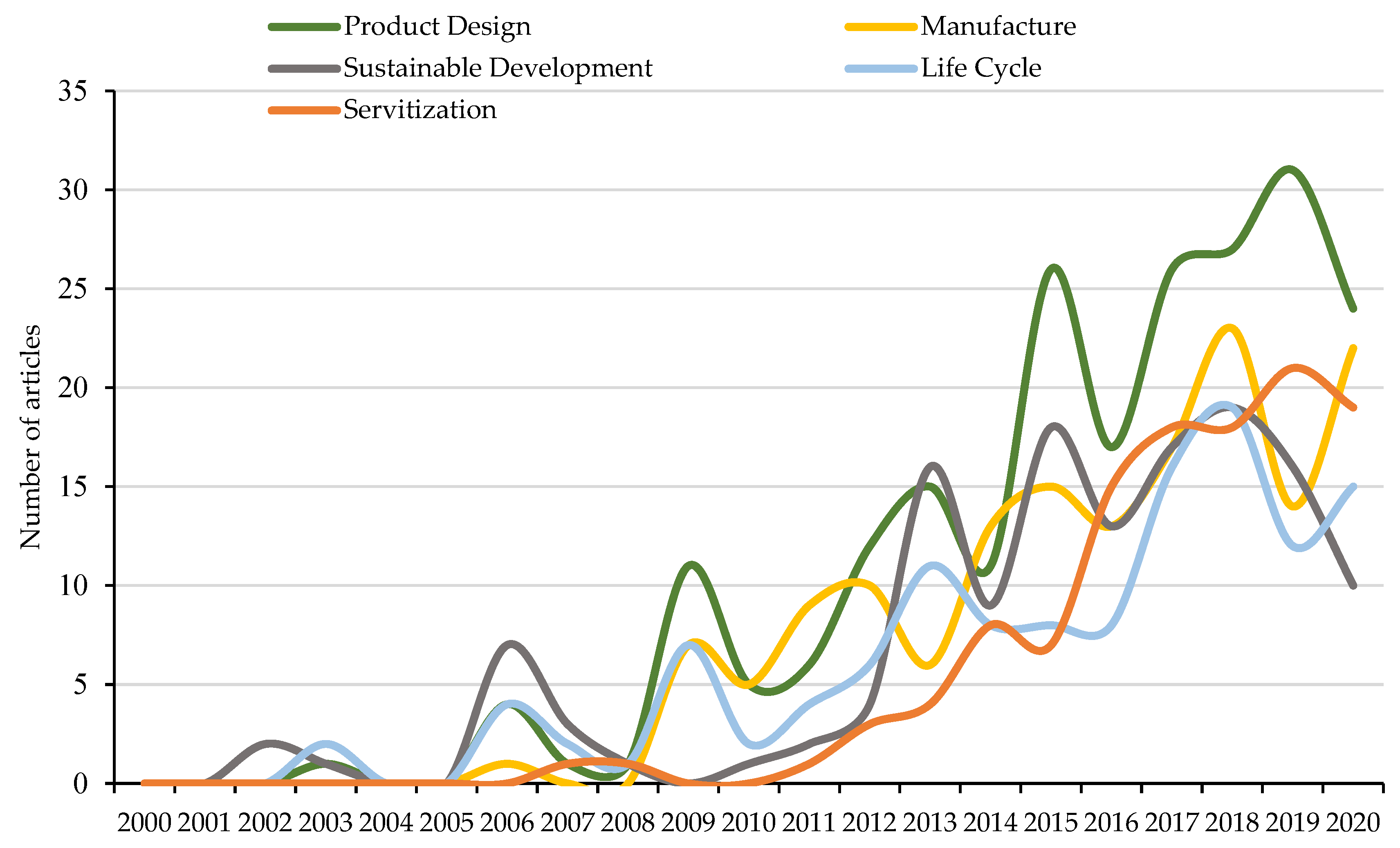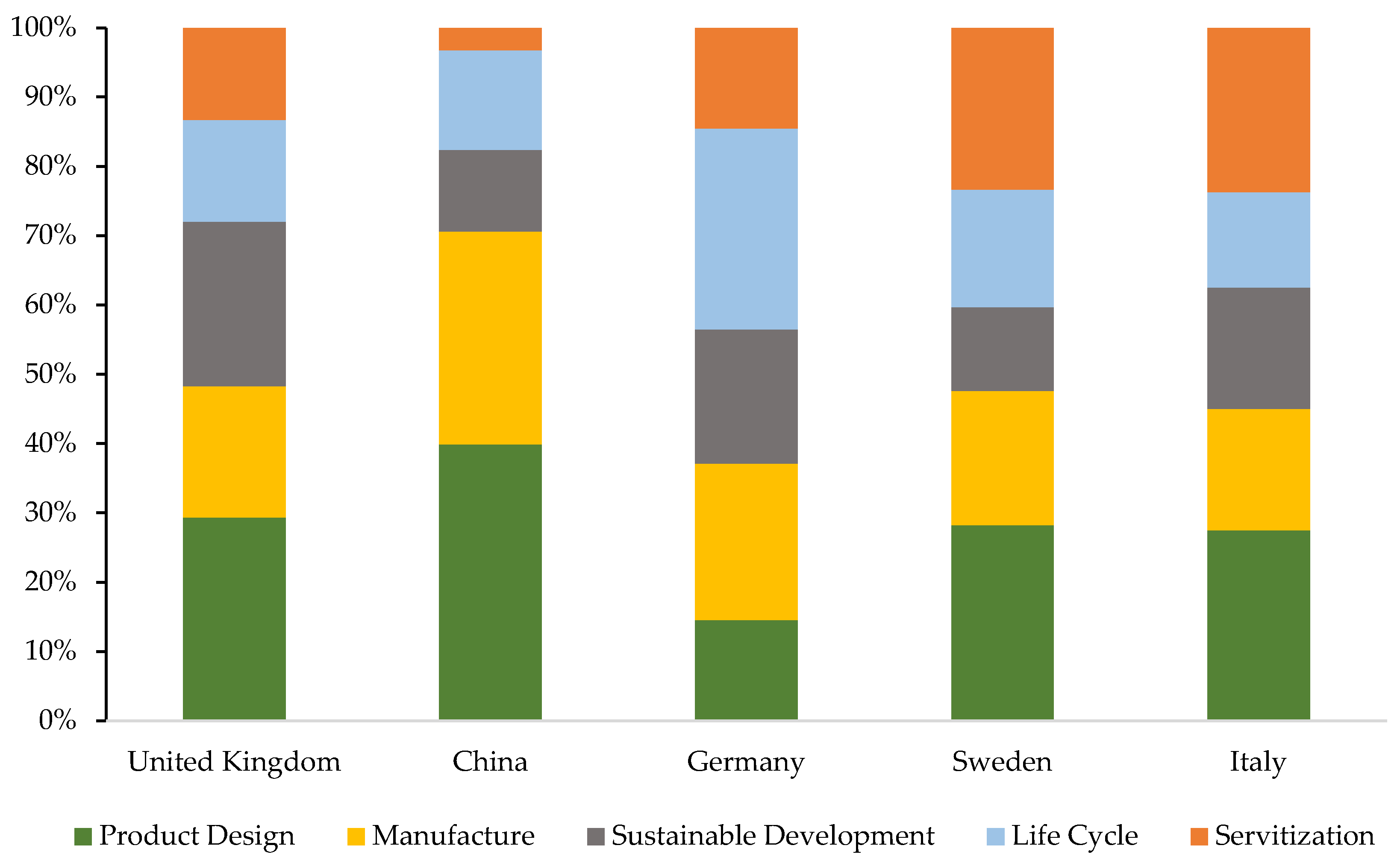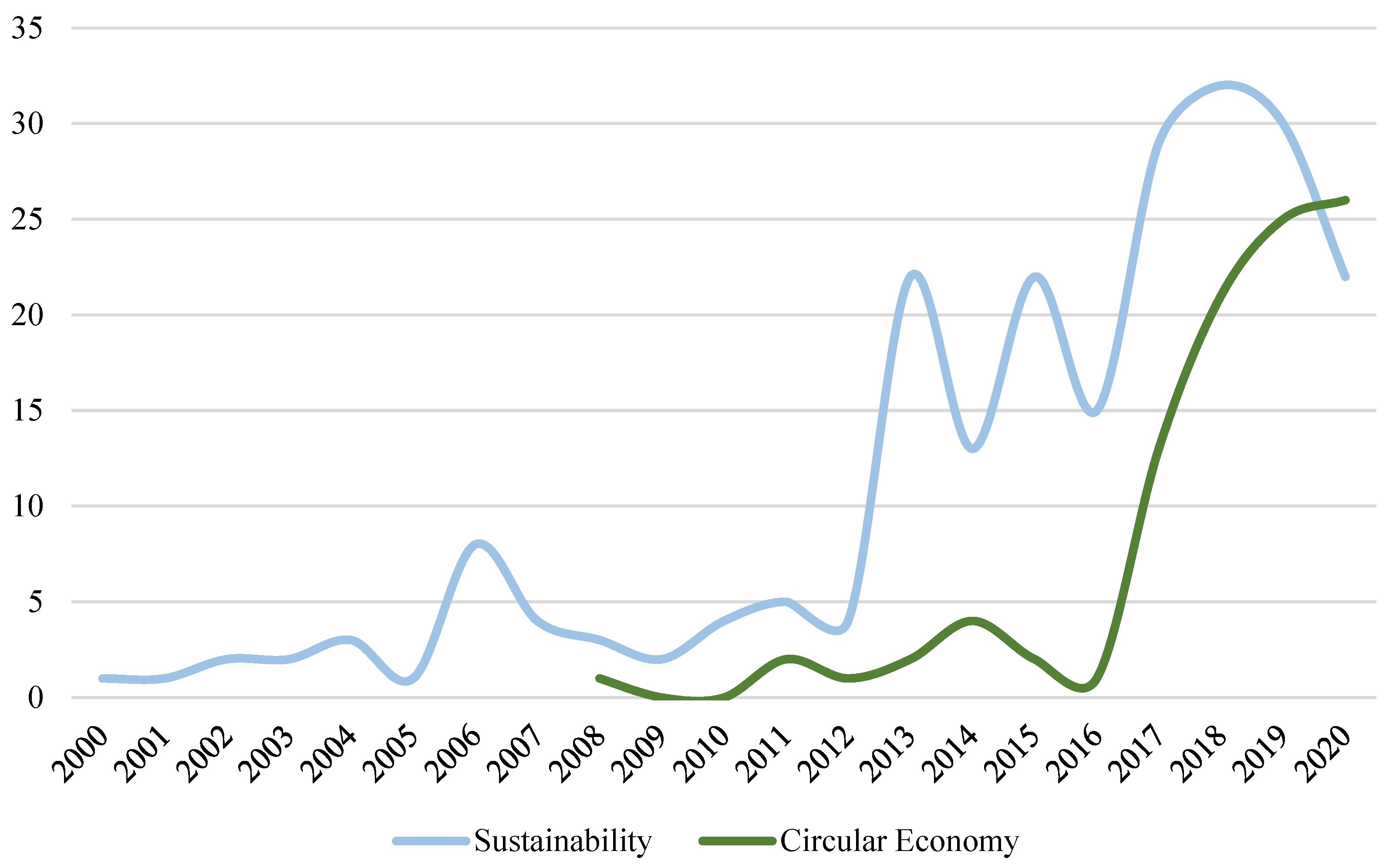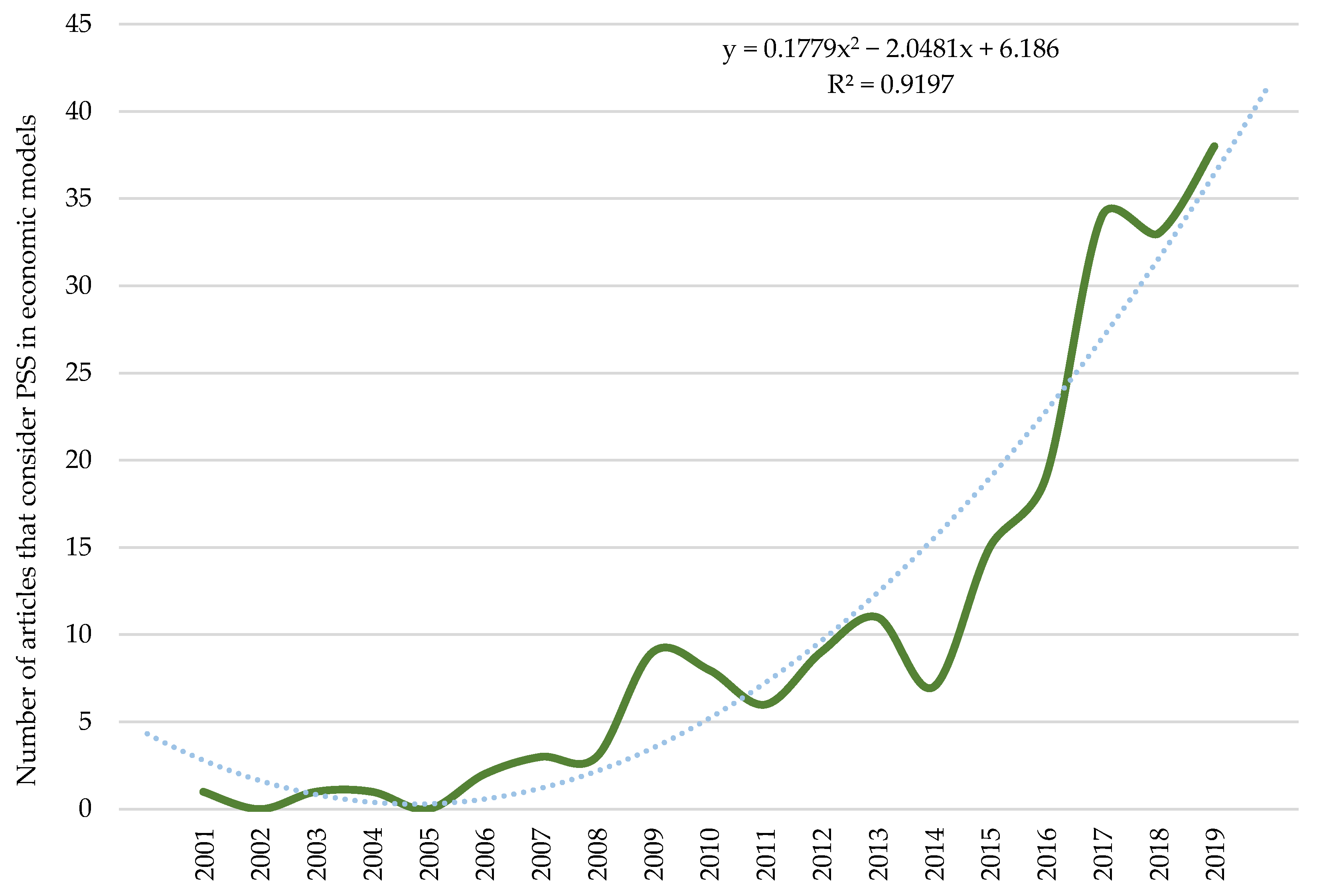4.1. Evolution of the Articles Ppublished
In this section, a general analysis of the scientific production oriented to PSS is carried out. The established time horizon begins in 2000 and ends in 2020, which makes it possible to cover all the articles, books, and book chapters made to date.
Table 1, which differentiates the analysis into three 7-year periods, shows the general growth trend experienced by this line of research. In the first period (2000–2006), a total of 31 contributions were published, compared to the 777 made during 2014–2020.
If reference is made to the authors who have published in the PSS line of research, from 2000 to 2006, a total of 49 authors are counted. In the second period, 2007–2013, this figure increases to 590 authors. Finally, in the last period, 2014–2020, the number rises to a total number of 1642 authors, a value that represents 78.90% of the total sample. The variable that relates the published research and the participating authors is the average number of authors, which goes from 1.6, in the first period, to 2.1, in the last two periods.
The countries also experience a general growth trend throughout the time horizon considered. From 2000 to 2006, 14 countries participated in this line of research. While, between 2014 and 2020, out of the 64 countries that make up the total sample of countries, 61 participated in this period. This means that in the last period analysed, only three countries (Liechtenstein, Venezuela and Israel) stopped publishing in this line of research.
Likewise, the growing interest in PSS is reflected in the number of citations. The first period (2000–2006) records 98 total citations, while the last period (2014–2020) reaches 26,143 citations. Regarding the number of journals, the first period (2000–2006) registers 10, while the last period (2014–2020) registers 259. Values that represent 3.13% and 80.98%, respectively, of the total number of journals (320) that publish the analysed scientific production.
Figure 2 shows the documents carried out annually on PSS. The sample obtained throughout the period considered is a total of 1088 documents, of which 2.85% belong to the first period analysed, 25.74% to the second period and 71.42% to the last period. As of the year 2017, more than 100 contributions are registered annually, and the year 2020 stands out, for having the largest number of publications (150). If the research published annually is compared, the lowest percentage of variation (−60%) occurs in 2005, as the number of documents is reduced from five to two. On the contrary, the percentage of greatest variation is recorded in 2006, with a value of 600%, going from two publications to fourteen.
The first research, as the graph indicates, is from the year 2000. This publication, by Robin Roy (2000), makes a brief review of the sustainable measures that have been developed throughout history. However, as this author assures in his publication, all of them have limitations, such as the absence to be able to modify the production and consumption model, or the impossibility of achieving an environmentally sustainable situation, exclusively with these actions. In this context, the author mentions for the first time the concept of PSS, as an opportunity to modify consumption and production models, and have a direct impact on sustainability.
However, the research carried out by Tukker and Tischner (2006) clarifies that the benefits of PSS, such as the improvement of the value chain and the reduction of costs, occur because of good acceptance by the consumer and a correct decision-making on the service to be offered. In this way, these authors ensure that benefits can be affected in each case, and that the introduction of PSS does not always represent a competitive advantage. Hence, they suggest expanding research to ensure the sustainability and full utility of PSS.
In the second period analysed (2007–2013), the highest percentage of variation (803.2%) is registered in the number of articles, authors, countries, citations, and journals. It is interesting to highlight the term “servitization”, which refers to the change from the exclusive sale of products to the product/services system, and which was used for the first time in 2007.
In the considered time horizon, investigations are carried out that satisfactorily and sustainably integrate the PSS. For example, research by Geum and Park (2011), which provides theoretical and practical information on design and integration. In numerous investigations of this period, the difficulties that can arise when introducing PSS in a traditional product are considered. An example of this type of publication is that made by Cavalieri and Pezzotta (2012).
In the last period analysed (2014–2020), PSS are considered a combination that can help the transition towards a CE, and therefore, improve the life cycle of products [
84]. However, it is not the only interest in this period analysed. Contributions such as those of Ingemarsdotter, Jamsin and Balkenende [
85] present the IoT as a useful tool to be able to offer a complete PSS. Specifically, they propose the possibility of connecting the services offered to customers to the internet, in such a way that the information can be constantly updated by the providers.
In this context, numerous actions are published by the United Nations (UN) and the European Parliament with the aim of joining forces and contributing to a favourable change [
86,
87,
88], although it is true that in the last two years analysed, the number of published investigations has stagnated. The trend as seen in the figure is positive, but the rate at which it is doing decreases significantly compared to previous years. In a way, this may be the precedent to a paradigm shift that includes new terms or interests in this field of study.
Currently there are various laws and regulations that try to respond to the changing needs of society and business models [
89,
90]. However, the low maturity of these concepts may be holding back the publication at the expense of the first results. However, the rise of this line of research is far from fading, as the challenges and research that are currently being posed remarkably fuel interest in finding effective solutions [
91,
92]. This evolution of the regulations and of the new terms identified in the scientific production will be expanded in the keywords section, since the main reasons that generate interest will be explained by periods
4.3. Distribution of Articles Published by Journal
The investigations developed can be published in a wide variety of journals, so they will be chosen according to the object of study and the perspectives of analysis that each one covers. In this way,
Table 2 shows the 20 main journals that publish on PSS, which are focused on various topics: sustainability, production, manufacturing technology, industry marketing, etc. This table provides information on the main characteristics of the journals, such as the articles published, the country to which they belong, the h-index of the journal [
93] or the quartile to which they belong in the SJR indicator [
83]. Moreover, in relation to the published documents, the total citations received, the average number of citations per document or the publication period are detailed.
These 20 international journals represent 6.25% of the total of the journals that publish on PSS (320). However, they group together a total of 495 contributions, which represents 45.50% of the total sample analysed. This table is led by European journals, specifically those of British origin, since almost 50% belong to the United Kingdom (UK). Regarding the impact factor, all the journals, except for the International Journal of Product Development, belong to the second or first quartile, the latter standing out for representing 70% of the journals considered.
All the journals have increased their publications throughout the time horizon, except for five of them that have a negative percentage of variation. In this context, the journal that occupies the second position, Sustainability, registers the greatest variation (5.10%) when going from 1 document between 2007–2013, to a total of 52 publications between 2014 and 2020. On the contrary, among the journals that experience a reduction in the number of published documents, the Journal of Manufacturing Technology Management stands out, going from 17 documents, in 2007–2013, to 6 publications, in 2014–2020, which translates into a variation of −65%.
The
Journal of Cleaner Production tops the table. This journal belongs to the Netherlands and has the highest value in published documents (123), total citations received (8906), average citations per article (72.41) and h-index in research (48). It is positioned in the first quartile, registers an impact factor of 1866, and it is the only journal in the table that published a document in the first period analysed (2000–2006), which makes it a pioneer journal in this field of study. Moreover, this journal has published the most cited research of the entire analysed sample, with a total of 1214 citations, under the title “clarifying the concept of product—service system” [
4].
The journal that follows is called Sustainability. This journal is of Swiss origin, has 53 publications, 404 total citations and an h-index of the journal of 68. It belongs to the second quartile, with an impact factor of 0.581, and its first research was published in 2013. The International Journal of Production Research has 42 publications and belongs to UK. This journal occupies the third position, however, it surpasses Sustainability in all the variables analysed, except in the number of publications made, since it has 1093 total citations, an average of 26.02 citations, an h-index of 20, and 125 in the journal. Furthermore, this journal has an impact factor very similar to the one that heads the table, and both are in the first quartile, unlike the second most prolific journal.
The CIRP Annals Manufacturing Technology journal occupies position 12. This journal, of American origin, despite having 13 documents, stands out for having the highest impact factor, with a value of 2544. In the opposite position, is the Wt Werkstattstechnik journal since it has the lowest value in all the variables in the table. This journal of German origin has 22 articles, but it has only 12 total citations, an average of 0.55 citations and an h-index in the publications of 2. Finally, the Journal of Business Research, in position 19, stands out for having the highest h-index in the journal. It has a value of 179 and even surpasses the journal that heads the table (Journal of Cleaner Production), which has an h-index in the journal of 173.
The diversity of categories studied by the most prolific journals stands out. The journal that heads the table, Journal of Cleaner Production, registers up to four different subject areas for the publications made on PSS. Specifically, there are publications on the disciplines of business, management and accounting, energy, engineering and environmental science. The same occurs for the rest of the sample, since if the study is extended to the three most prolific journals, a total of 6 disciplines are covered, of the 23 registered. These data reflect the multidisciplinary nature of PSS, as there is not only room for studies focused on a specific area. An example of this are the publications that consider PSS as an improvement for the life cycle of products and their performance. In this case, not only the economic results that could be generated are investigated (category of business, management and accounting and economics, econometrics and finance), but also, the environmental benefits that could cause (environmental science and earth and planetary sciences) and the processes that could ensure proper integration (decision sciences and computer sciences).
The following section mentions the scientific production carried out by the most prolific countries, institutions, and authors, who serve varied interests and disciplines.
4.5. Keyword Analysis and Research Trends
Before analysing the keyword sample, a consolidation process was carried out to process minor variations in the terms obtained. Specifically, concepts were unified that, having the same meaning, were differentiated by their writing (accents, capital letters, hyphens, plurals, abbreviations, acronyms, etc.). After this process, 5475 keywords were registered with a total of 11,483 occurrences. The number of existing keywords is higher than the total number of documents analysed, since each investigation may use more than one term to correctly define the scope of study.
In this section, information is first provided for each of the three periods analysed individually, and subsequently, the main keywords for the entire time horizon considered are presented. The first period analysed (2000–2006), has 31 documents and a total of 231 keywords. The terms “product development”, “sustainability”, “environmental impact”, “sustainable development” and “life cycle” stand out for registering the highest number of occurrences. Research from this period focuses on finding alternatives that can improve future sustainability, as well as reduce the excessive use of natural resources or edit consumption and production patterns. In this context towards an environmental improvement, numerous measures and action plans are published by the European Union that help to achieve these objectives. In
Table 7, some of these actions approved during the analysed period are mentioned.
A methodology based on the lexicon used has been carried out through the search for keywords that contain the concepts of sustainability, environment, natural resources, etc., in the regulations. The measures presented by the European Union, to deal with sustainability problems, are completed by the research carried out in this first period analysed, thus demonstrating the direct relationship established. In this way, while the keywords are used in the investigations, the regulations set objectives that seek to change unsustainable consumption habits, improve sustainable production, avoid the production of large amounts of waste, and pursue a responsible use of renewable natural resources, improve the performance of production processes, consider the complete life cycle of products, or improve waste management.
The second period analysed (2007–2013) registers new regulations and agreements that promote sustainable actions by companies and consumers, at the European, national, regional, and local level (see
Table 8). After carrying out a lexical analysis of the regulations of this new paradigm, new challenges are presented to face, such as the need to be more energy efficient in production processes, promote the design of products with fewer resources, improve the potential environmental performance of the industry itself or seek competitive advantage in the efficiency of the PSS itself.
The keywords with the highest number of occurrences in this second period analysed are “product design”, “life cycle”, “innovation”, “industry” and “customer satisfaction”. The number of investigations in this period (2007–2013) amounts to 280 and the number of terms used in these publications reaches 1961 terms. It is interesting to mention the existence of research that has been financed by the European organizations themselves, with the aim of finding solutions to the challenges of the moment. Within the Community Support Framework 2007–2013, programs such as “The Framework Program for Research, Technological Development and Demonstration (2007–2013)” [
105], these have been in charge of financing research projects related to numerous topics.
On the other hand, it is pointed out that, in this second period, the investigations carried out by non-European countries (China, USA, Japan, etc.) begin to be registered among the main positions, so there may be a slight variation between some European regulations and what is established globally and, therefore, the interests developed in scientific publications. Therefore,
Table 9 provides information on the main events worldwide, which affect all countries that are part of the scientific production on PSS.
In the third period analysed (2014–2020), new terms were used, reaching a total of 3966 keywords. In this case, the terms with the highest number of occurrences in the investigations are “servitisation”, “decision making”, “circular economy”, “sales” and “competition” (see
Table 10). From the perspective of legislation, the objectives focus, among others, on strengthening the decisions taken, taking advantage of the new opportunities of the circular and collaborative economy to complete the PSS, expanding the policy frameworks with binding objectives, achieving an integrated approach to the production-consumption systems, or investing in environmental technology and ecological innovation [
51,
110]. The importance of the measures carried out at the international level is highlighted, since as can be seen, the regulations promote research and the development of new possibilities.
To continue with the analysis of the complete time horizon, in
Table 11, the 20 main keywords of all the research carried out are represented. These refer to 0.37% of the total keywords but represent 13.8% of the occurrences made. It is clarified that the terms that have been applied in the search for this study itself, such as “product-service system” or “PSS”, have not been considered in the table.
Between 2000 and 2006, 40% of the words that are currently considered keywords in research had not been used in any study. Some of these terms were: design, supply chain, business models, or industrial research. In the second period, these keywords began to be considered relevant for this field of research, going from 0 occurrences to a minimum of 10, except for the term CE, which was only mentioned in one document.
Finally, in the last period analysed (2014–2020), all keywords began to be used frequently in publications, until they were considered as the terms with the most occurrences in the line of research on PSS.
Table 11 is headed by the term product design. In the 21 years analysed, it has appeared in a total of 218 documents, of which 162 occurrences belong to the last period analysed (2014–2020). The second term, with a total of 156 documents, is manufacture. This keyword stands out for being the term in the table that has experienced the highest percentage of variation between the first period (2000–2006) and the second period (2007–2013), since it went from 1 occurrence to 37. The term that occupies the tenth position, CE, stands out as the keyword that has experienced the greatest variation between the second and third periods. This is because it went from being mentioned in 1 research, between 2007–2013, to having 60 occurrences, between 2014–2020, which reflects the recent relationship that is being established between the term of PSS and the CE.
Figure 7 represents the keyword network based on co-occurrence. Each cluster groups together a set of terms that generally refer to the same object of study, therefore, in this case, 6 different areas of interest can be distinguished.
The first cluster, in red, is represented by the terms products and services, customer satisfaction, servitisation, and value creation. The keywords used are related to the new business concept that the industry is focusing on, which is intended to offer customers a complete service that goes beyond the mere sale of products. This is reflected in the creation of value for the business model itself and an increase in customer satisfaction.
The second cluster, in light blue, is led by terms such as product design, conceptual design, costumer requirements and quality function deployment. This set of terms refers to the technical part of PSS, which must meet a series of quality standards and respond to the functions that the client himself expects from the system that is offered.
Third, the dark blue cluster is made up of the concepts of manufacture, optimization, costs, supply chain management and production engineering. This cluster represents the investigations that contemplate the improvement in its production chain or in the optimization of costs, which are benefits of implementing the PSS correctly.
The fourth cluster, yellow, is represented by the terms life cycle, system engineering, competitive advantage and development process. The terms included in this cluster are related to the very line of research that is being analysed, that is, the possibility of positively influencing the competitiveness of the industry through the offer of a product/service system that allows expanding the cycle of lifetime.
The green cluster is led by the concepts of CE, economic analysis, business development, business modelling and business model innovation. This set of terms establishes a relationship between the PSS and the economic part. It could be said that in this cluster the costs of its introduction into the industry are considered, as well as the sales or benefits that would be obtained.
Finally, the purple cluster refers to the sixth group of terms. In this case, scientific production focuses on the possibility of positively influencing the environmental situation through the PSS themselves. An example of the issues that are considered in the research is that of enjoying a service without having to physically own the product that offers said desired service, so this new paradigm could generate new benefits both for the life cycle of the products as well as for the environment. The terms used in this last cluster are sustainable development, waste management, eco-design, or life cycle assessment, among others.
To complete the analysis of keywords,
Figure 8 shows the period in which each term has been incorporated into scientific production. The concepts are arranged in the temporal space from 2013 to 2018, and vary in colour, from dark blue to yellow, depending on the maturity of the term itself.
The first concepts that appeared in this line of research are development process, service design, business model and optimization, as has been seen in the objectives of European regulations. This group of words refers to the beginning of a new concept that needs to be investigated to answer the doubts that arise about whether it is sustainable, improves competitiveness, or optimizes the production process.
The concepts that emerge in the second period, around 2015, are eco-design, competitive advantage and supply chain management. These terms refer to the PSS as a reality in which the consequences of introducing it in the industry are beginning to be valued, as well as the need to invest in environmental technology, or technological innovation. Finally, the concepts of sharing economy, Industry 4.0, IoT and CE have been the last to be introduced in this field of research. In this last period, scientific production focuses on assessing the benefits from its offer in the market, as well as the possibility of combining different existing tools, such as the collaborative economy, IoT or the advancement of technology, to improve benefits.
Chronological analysis provides information about the approximate date of incorporation of keywords into publications. However, the high volume of concepts used throughout scientific production makes it difficult to visualize the evolution of the main terms. Therefore,
Figure 9 shows the five keywords with the most occurrences, as well as the number of publications in which they have been considered throughout the period studied.
The five keywords with the highest number of occurrences are those at the top of
Table 11, specifically product design, manufacture, sustainable development, life cycle and servitisation. This analysis allows knowing the terminological preferences in the scientific production of PSS and the presence of these terms for each year analysed.
The first term, product design, has a total of 218 occurrences throughout the 21 years analysed and is represented in green. The first occurrence dates back to 2003 under the investigation “Product-Service Systems, A Perspective Shift for Designers: A Case Study—The Design of a Telecentre” [
113], although it is from 2006 when it begins to register occurrences annually. The highest percentage variation is registered in 2009, since it has 11 occurrences compared to 1 in 2008.
The second keyword that heads this classification is manufacture, with 156 occurrences and represented in yellow. The first time this term was used was in a publication made by the
Journal of Cleaner Production, specifically in 2006 [
114]. As of the year 2009, this concept begins to be considered annually in scientific publications, and the greatest percentage variation, with a value of 117%, occurs in 2014, from 6 occurrences to 13.
The third key phrase considered in the
Figure 9 is sustainable development. This term is represented in grey and has a total of 138 occurrences. The first year in which this term was mentioned was in 2002 with a total of two occurrences, both investigations being published in the
Journal of Cleaner Production [
4,
115]. The highest percentage variation (300%) in the number of occurrences was recorded in 2013, from 4 occurrences to 16.
The fourth term considered is life cycle. This keyword, which is represented in blue, has a total of 125 occurrences. The first two documents that referenced this term were published in 2003 [
116,
117], and it was as of 2006 when it was considered annually in the PSS investigations. This term registers its highest percentage variation with a value of 600%, in 2009, since it goes from one occurrence to seven. Servitization is the keyword that occupies the fifth position by the number of occurrences (117 records). In the
Figure 9 is represented in orange, and its first occurrence can be seen in a 2007 publication [
94]. Since 2011, it is considered annually in the investigations, and the highest percentage of variation (200%) occurs in 2012, going from one occurrence to three. Finally, 2012 stands out as the year in which the five keywords analysed began to gain special relevance in the scientific production of PSS.
Table 12 presents the top five terms used by the most prolific institutions. To obtain these keywords, a debugging process has previously been carried out to eliminate those concepts that, although having a high value in the number of occurrences, were terms that did not provide information (priority journal, article, research, investigation, etc.) or that referred to the analysed search itself (product-service systems, PSS).
The main keywords for each institution make it possible to differentiate the lines of research carried out by each of them. Institutions such as Delft University of Technology focus their research on the design of a product that addresses an environmental dimension, using concepts that refer to sustainable development or the introduction of environmental costs (eco-costs). Other institutions, such as Luleå tekniska Universitet, focus more on the technical side of design, having terms such as manufacturing, product development, or product design. Although many interests can be differentiated, since other institutions are registered that are inclined towards business models with terms such as decision making, sales or customer requirements. It stands out that all prolific institutions, except for Vaasan Yliopisto, register among the five keywords, the term product design. Finally, none of the institutions has geographical concepts among the most used terms for PSS publications.
To conclude with this section,
Figure 10 represents the percentage of repetition represented by the keywords in the investigations of the five most active countries. The product design term is the one that receives the highest percentage of repetition for all countries, except for Germany, which registers the highest percentage in the life cycle term. The lowest percentage for the three most prolific countries is received by the fifth term (servitisation), while for the fourth and fifth countries, the lowest percentages are registered by sustainable development and life cycle, respectively. China, with 39.87%, is positioned as the country that registers the highest percentage of repetition, specifically for the term product design (39.87%). Furthermore, this same country registers the lowest percentage of repetition, specifically in servitisation with 3.27%. In this way, the figure graphically represents the presence of each of the main terms, with the aim of knowing to what degree they are considered in the investigations of each country.
4.7. Discussion
The results of the bibliometric analysis illustrate the exponential growth that has occurred in publications, since in the last five years 547 contributions have been reached, which represents 50.28% of the total sample. This is supported by the growing interest in presenting alternatives to traditional consumption models that are environmentally responsible as well as competitive [
1,
2,
3]. In fact, there are currently different areas of study associated with PSS, such as sustainability, SPSS [
44]. Regarding the beginning of this line of research, the first publication that mentioned the term PSS dates from 2000, written by Roy. At present, with a high percentage of variation in the number of publications, the sample reaches 1088 contributions. This expansion in the scientific production of PSS may be due, in addition to the importance that is given at present, to the multidisciplinary nature of the subject, since the studies require not only technical knowledge, but also environmental or economic knowledge, among others [
21,
40].
The two main thematic areas, which stand out for their percentage of representation compared to the analysed sample, are engineering and business, management and accounting with 685 and 475 publications, respectively. In fact, this is confirmed by the European regulations analysed, which register periods with a high commitment by the industry, innovation and product design [
108] and other periods with a high interest in CE, competition and sales [
112]. On the other hand, in the ranking of the twenty most prolific journals, their relative importance stands out, since they all belong to the first and second quartiles, except for
International Journal of Product Development, which is in the third quartile. Among the sample of journals analysed,
Journal of Cleaner Production holds an advantageous position compared to the rest of journals, since it leads the ranking in the three periods analysed. Its success is due, among other reasons, to the publication of the most cited article in the analysed sample, which clarifies and defines the concept of PSS [
4]. Even so, the
Journal of Business Research and
CIRP Annals Manufacturing Technology are also given prominence, for surpassing the h-index and impact factor, respectively, of the journal that heads the ranking.
The number of authors participating in this line of research amounts to 2081, being Tomohiko Sakao, with 33 contributions, and Fabrizio Ceschin, with 22, the most prolific. In this classification, the pioneer of this term, Roy R., has the highest value of citations (2182) and average of citations (145.47), compared to the rest of the authors. In order of importance, the institutions Linköpings Universitet and Shanghai Jiao Tong University are classified, having 57 and 51 publications, respectively. However, the institution that occupies the third position, Cranfield University, surpasses the previous two in citations received, average of citations and h-index.
In geographical terms, a greater involvement is detected at the global level, since it goes from 14 countries active in the research, to a total of 61 countries for the last period analysed. Specifically, UK and China stand out for having a positive impact on PSS research and the highest values in publications. Finally, the countries that register the highest collaboration, with values of 77.42% and 70.91%, are Finland and USA.
The study reveals that the main keywords used throughout the scientific production on PSS are: product design, manufacture, sustainable development, life cycle and servitisation [
114,
115,
117]. Said concepts have been addressed at the beginning of the research and are considered representative in the field of study. Finally, the realization of network maps establishes the main links between these terms, and mentions the areas of interest investigated, highlighting the two most representative concepts currently, CE and sustainability. These data reveal the growing expansion of the field of study to other disciplines, allowing for the expansion of concepts and the correct delimitation of the direct relationship established with each of the terms studied.
